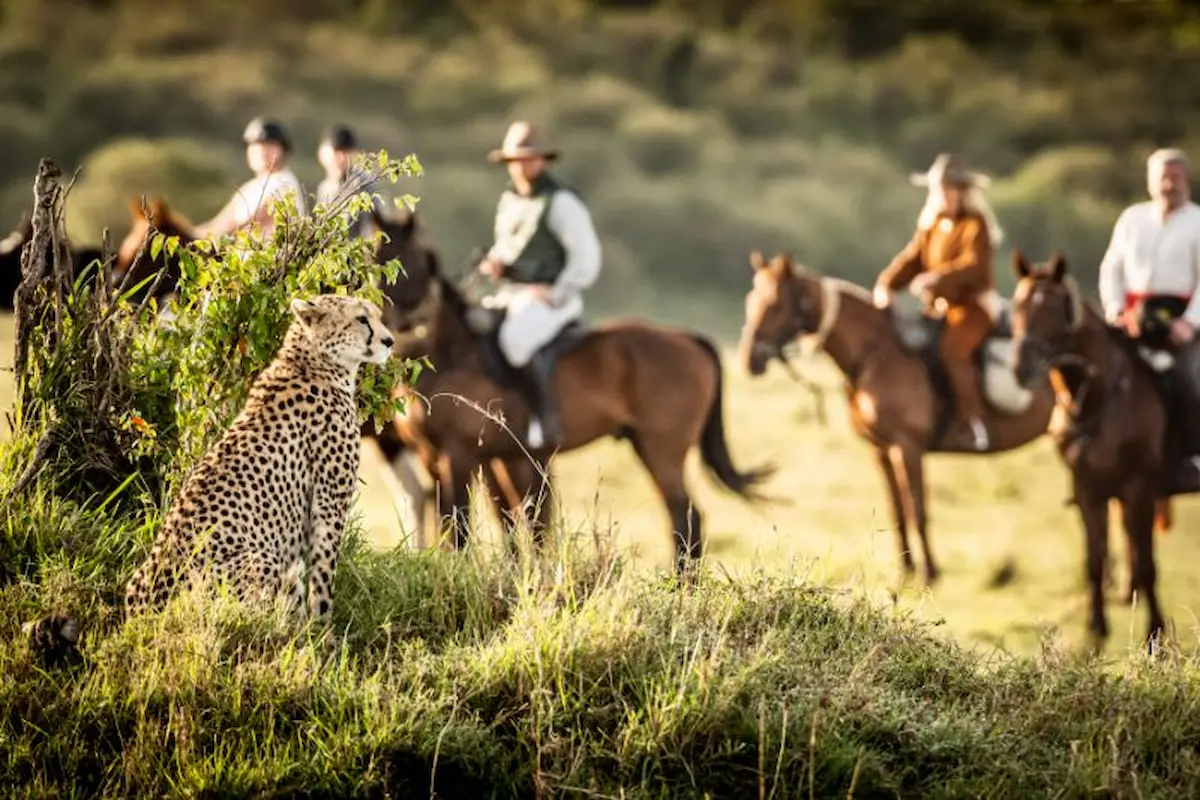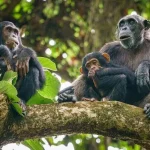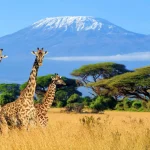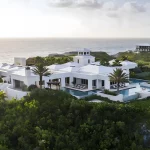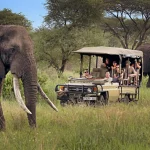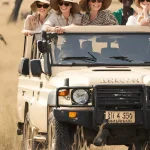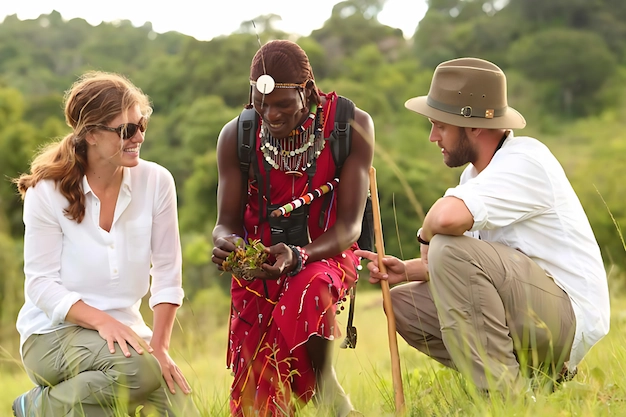Tanzania is a perfect escape from which to explore nature, landscape, culture, and more. This lovely country hosts the most captivating tourist destinations. Serengeti National Park is the icon of this beautiful country. Its richness in wild animals makes it a perfect place for wildlife viewing.
Mount Kilimanjaro stands tall in northern Tanzania. It is undoubtedly the highest peak in Africa. The glorious Ngorongoro Crater is a beautiful natural feature in Tanzania. The Hadzabe bushmen, Maasai nomads, Datoga, and 120 other tribes make Tanzania an excellent destination for cultural exploration.
There are many ways to explore the natural beauty of this fabulous country. You can embark on game drives on a 4×4 vehicle. You can also explore this country from atop, either on a hot-air balloon ride or a helicopter safari. Other safari experiences include boat cruises, village tours, beach stays, walking safaris, biking tours, and horseback safaris.
Exploring Tanzania on a horseback safari is a life-changing journey among the other tourist activities. We at East Africa Safari Guides uniquely bring this exciting activity. We organize both private horseback riding safaris and budget horseback riding safaris in Tanzania. Different safari lodges also offer this thrilling safari experience.
Where to go for a Tanzania horseback safari
Visitors can go on horseback safaris to different destinations in Tanzania. We have listed some exciting destinations in Tanzania for horseback riding.
Horseback Safari in Serengeti
There is no need to worry about Serengeti’s magnificence in terms of wildlife. In Serengeti, you can explore the great wildebeest migration, the most significant mammal migration on earth.
Serengeti Migration Horseback Safaris
A Serengeti horseback safari brings you close to the migratory animals. This safari enables you to explore the great wildebeest migration on horseback. You also have the chance to see various wild animals, including elephants, buffaloes, zebras, giraffes, antelopes, and many more.
The Great Migration is a seasonal event. The Serengeti Migration horseback ride offers different experiences depending on travel time. Here are the highlights of the major events that happened during the Great Migration:
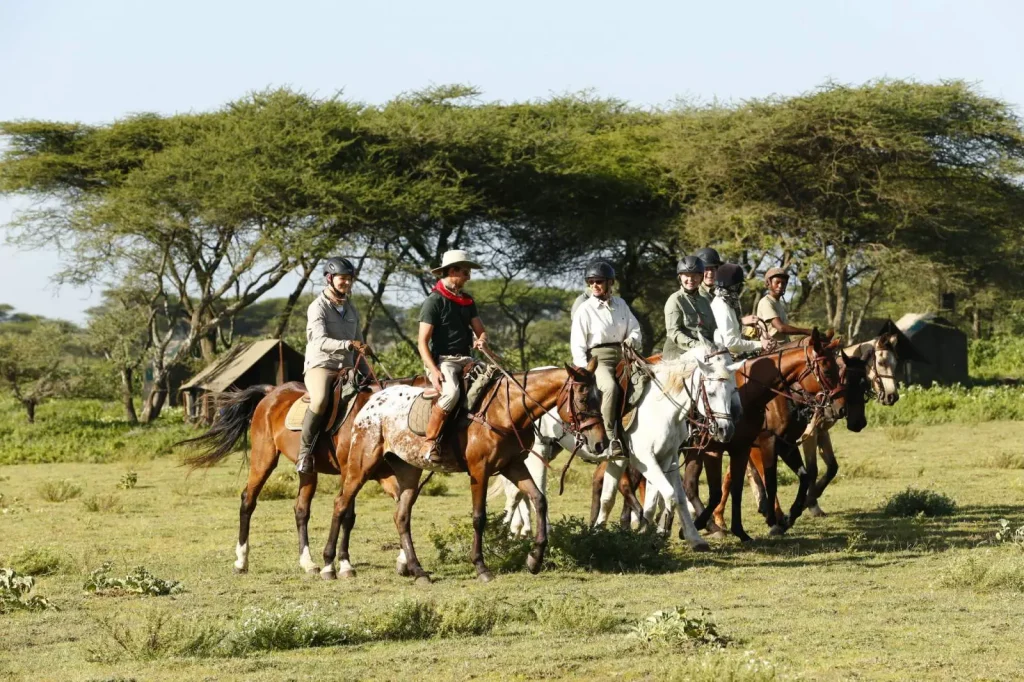
The calving season is the pioneering event of the Great Migration. It happens in southern Serengeti between January and March. A safari on horseback through the Ndutu is exciting since you will witness thousands of calves in the wet season.
The predator-prey dynamic is another unforgettable wildlife safari event to witness while on a horseback safari. The predators take advantage of the calves.
The central Serengeti hosts the Great Migration between April and June. You can trek the wildebeest in the Seronera on a horseback ride. This region is also rich in big cats, such as lions, leopards, and cheetahs. You can enjoy sightings of these carnivores in Kopjes and along the banks of the Seronera River.
The Mara River crossings happen in northern Serengeti between July and August. Here, you will see the wildebeest brave this giant river while the Nile crocodiles try to get their kill. It is a fatal incident, but Wildebeest has no option but to cross the river.
We at East Africa Safari Guides recommend you for an 8-day Serengeti migration horseback safari. You can also plan for a shorter or longer safari program.
The Great Migration is hard to predict. But we are sure you will see some events, such as massive trekking in the plains. Events like Mara River and Grumeti River crossings may change occasionally.
Horse-riding safaris in Singita Grumeti Reserve
A horseback safari in Singita Grumeti Reserve is more rewarding. Where is this reserve located? Singita Grumeti Reserve is a private concession on the western corner of Serengeti National Park. In this private concession, you will enjoy various activities restricted in Serengeti National Park.
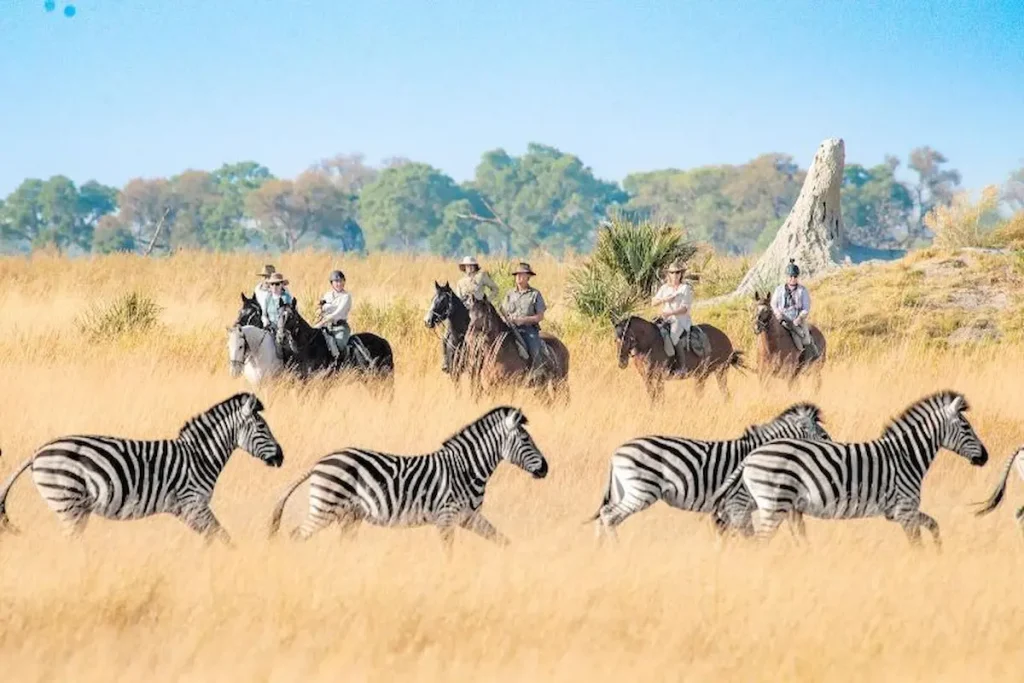
On horseback safari, you can explore the wildlife, vegetation, and landscapes in this private concession. Between July and August, the wildebeest migration crosses this 14,000 – hectare reserve. You can view the Grumeti River crossings from this reserve. After crossing the Grumeti River, the wildebeest head northward, where they cross the Mara River into the Masai Mara.
Ngorongoro Horse Riding Safaris
Ngorongoro Conservation Area is a UNESCO World Heritage Site. Its primary attraction is the Ngorongoro Crater, the world’s largest intact caldera. This scenic caldera is home to many wild animals that thrive on its crater floor. It is perfect for a wildlife horse safari in Tanzania.
Visitors can see the Ngorongoro Conservation Area on their horseback safari to Serengeti National Park. Ngorongoro Crater hosts a large number of large animals and birds. Visitors can see the Big Five and colorful birds as they embark on a horse-riding safari in Ngorongoro Crater.
Olduvai Gorge is another thriving place worth a visit. A horseback ride to Olduvai Gorge will teach you a lot about the history of man. Dr. Leakey excavated the hominid remains. After visiting the Olduvai Gorge, you can see the footprints of hominids at Laetoli, south of the Olduvai Gorge.
You can also ride to the Maasai of Ngorongoro Conservation Area. They are welcoming people who still live their lives traditionally and coexist with the wild animals in Ngorongoro.
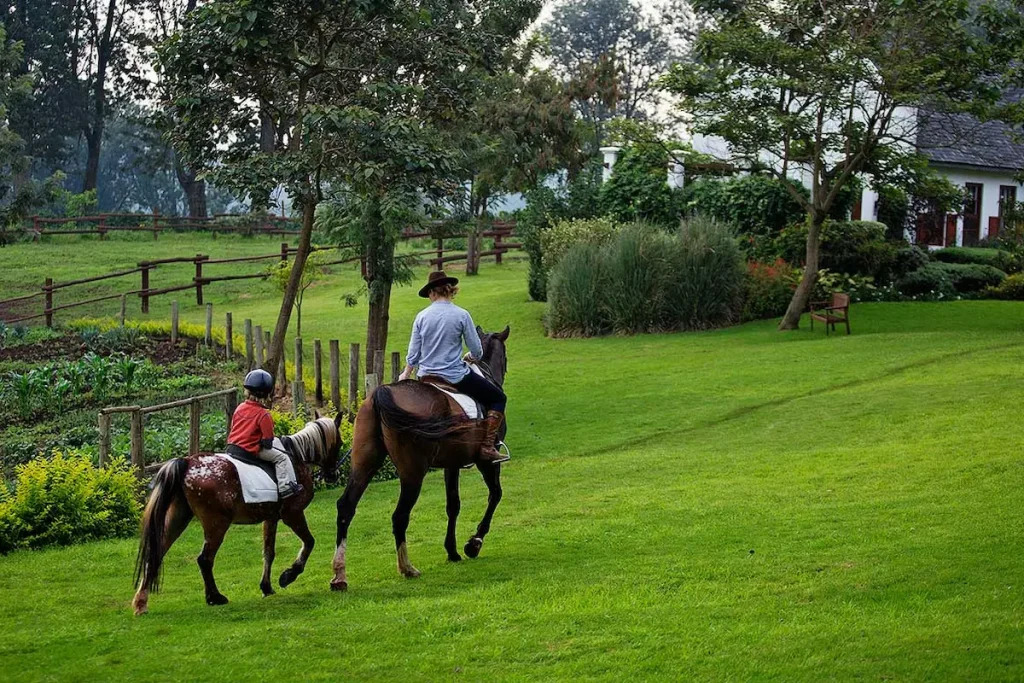
The Maasai are great artisans. They create beads, bracelets, and other goods. It will be glad to have your support for their creativity. These people also do their traditional dance, which involves jumping while singing traditional hymns.
Kilimanjaro horse riding safaris
This is the favorite destination for horse riding safaris. Many tour operators operate horseback riding safaris in Kilimanjaro National Park. Besides Mount Kilimanjaro, Kilimanjaro National Park hosts wildlife, scenic rivers, escarpments, and small lakes.
Horse riding safaris in Kilimanjaro start at Makoa Farm, a veterinary clinic where horses and other animals are cared for. From there, you will ride through the vastness of Kilimanjaro National Park.
Among the incredible animals found in this park, the African elephants are the most beautiful. Kilimanjaro horseback safaris usually aim to learn the behavior of these wild giants from a close distance. Other wild animals that you can see in Kilimanjaro National Park include monkeys, antelopes, and giraffes. You will also enjoy the scenic view of Africa’s highest peak.
You can also ride to the surrounding community, the Chaga. They are excellent farmers who grow coffee and other crops.
Horse-riding safaris in Lake Manyara National Park
Lake Manyara National Park is an incredible national park in Tanzania. Its beautiful scenery, diverse wildlife, and eye-catching alkaline lake make it perfect for horseback safaris.
On a horseback ride in Lake Manyara, you will get close to herds of elephants, buffalos, zebras, and more. You can also view tree-climbing lions. This unique species of lion is in Lake Manyara National Park and Queen Elizabeth National Park only.
As you ride close to the shores of this alkaline lake, you will see beautiful pink flamingos. These birds dominate Lake Manyara’s shores, creating this soda lake’s pink appearance from a distance.
You can give horses time to rest as you try other things. You can get off the horseback to try a fantastic activity. Experience a treetop walkway. View the vegetation, monkeys, and many other things on top of trees.
You can also go on a canoe trip to Lake Manyara. The hot springs neighboring Lake Manyara are another place worth a visit on horseback.
Horse-riding safaris in Tarangire National Park
Tarangire National Park is a fantastic wildlife park in the Northern Circuit. Its vegetation consists of plains and woodlands dotted with ancient baobab trees. The park also boasts a large population of elephants.
When riding horseback in Tarangire National Park, ride close to the banks of the great Tarangire River. During the dry season, many wild animals gather around this river, and their sightings are guaranteed.
Your guide will get close to the herds of elephants roaming freely in the grassy plains. Tarangire National Park also hosts several wild animals, such as zebras, antelopes, warthogs, giraffes, and many others.
Horse-riding safaris in Arusha National Park
Arusha National Park hosts many natural attractions, including Mount Meru, Momella Lakes, Ngurdoto Crater, and many more. It also has a large population of animals.
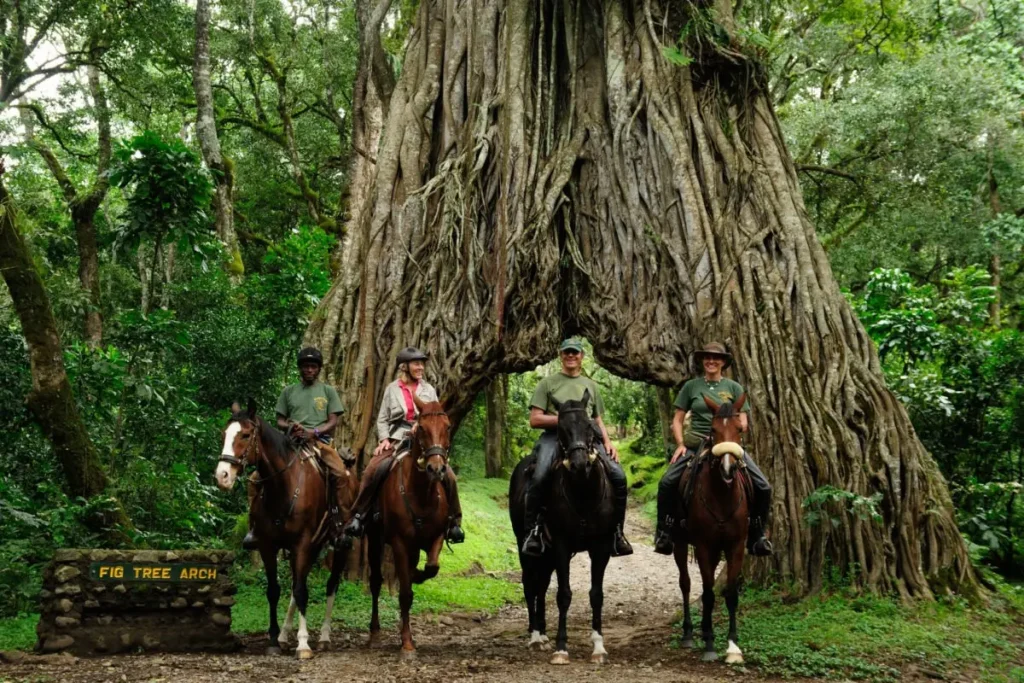
You can ride on horseback on the slopes of Mount Meru through the lush mountain forests. You can witness wild animals, including buffaloes, warthogs, zebras, and antelopes. Ngurdoto Crater is perfect for game viewing. You can also ride to the plains, like “Serengeti Ndogo,” where you will see plenty of grass-eating games.
Horseback safari at Dolly Estate
If you want a more private horseback safari, Dolly Estate is your ultimate destination. Dolly Estate is a pristine wildlife sanctuary on the outskirts of Arusha city, just a 45-minute drive from the city. This dazzling land offers magnificent views of wildlife and the African landscape, Making it a perfect place for horseback safaris.
Horseback safaris at Dolly Estate are captivating. You can spot beautiful wild animals like zebras, wildebeests, dik-diks, and antelopes. On a horseback safari, you can get close to zebras and wildebeests grazing in open plains. Dolly Estate offers enchanting views of flora and fauna.
Enjoy the scenery as you ride slowly in the forest. Stare at a beautiful bird. Meet the locals neighboring Dolly Estate. All these and many more make a horseback safari at Dolly Estate memorable.
Horseback safaris at Dolly Estate suit beginners and experienced riders. The ride can last for 2 hours or less. Experienced riders lead this wonderful experience at Dolly Estate.
Horse riding in Lake Natron
Lake Natron is a fantastic alkaline lake in northern Tanzania. It is in the Gregory Rift, the eastern part of the Great Rift Valley. Horseback safaris are available on the outer slopes of the Ngorongoro Highlands.
You will ride on horseback in Lake Natron to discover its alkaline water, which is hostile to most life forms. You can extend the horse ride to Mount Ol Doinyo Lengai, an active volcano in Tanzania.
Lake Natron is a breeding site for over 2.4 million lesser flamingos. It is a gorgeous scene to see these species of birds on a horseback safari, especially in the dry season. In the dry season, the lake shrinks, leaving a large part of dry land for riding. Therefore, we advise you to take a horseback safari in February and from June to October.
Why you should go on a horseback safari in Tanzania
Horseback safaris have exceptional rewards for casual ways of exploring wildlife. Animals are not as afraid of horses as cars and pedestrians. Therefore, you can get a little closer to animals on horseback.
Moreover, you will not go off-road on a game drive in public national parks. On horseback, you can ride off the road to areas reachable only by horses.
Horseback safaris are perfect for exploring nature slowly compared to game drives. You have the chance to explore these wonders uniquely.
Horseback safaris are also eco-friendly. You will explore nature sustainably, leaving little or no carbon footprints in the wild. Therefore, horseback safaris are highly recommended.
What should you bring on your horseback safari in Tanzania?
While you can get all it takes to book a horseback safari from your tour operator, it is crucial to bring the following items:
Gloves: Horseback riding safaris may cause pressure on your fingers, causing blisters. Sometimes, you may be riding in the sun. Therefore, it is vital to bring gloves to protect your hands.
Boots: Boots help to avoid any unforeseen accidents that may happen during your horseback riding safari.
Riding hat: It is essential to bring a riding hat or a helmet on your horseback safari. This will help protect you from the sun.
The above things should not make you worry. If you don’t have these items, East Africa Safari Guides will provide them. They will give you a helmet or riding hat, boots, and gloves.
Tanzania is a perfect destination for African horseback safaris. East Africa Safari Guides offers guided horse safaris to Tanzanian destinations. Our guides are experts at riding and finding the best spots for you to enjoy the scenes. The horses are healthy and well-trained.
Our horseback safaris are available on a private, shared, or family basis. If you want to explore Tanzania on horseback, book a trip with East Africa Safari Guides.
Ready to ride a horse in the wilderness?
One email is enough to kick-start a conversation to tailor your dream safari. Our safari experts are wholeheartedly waiting for your request.

